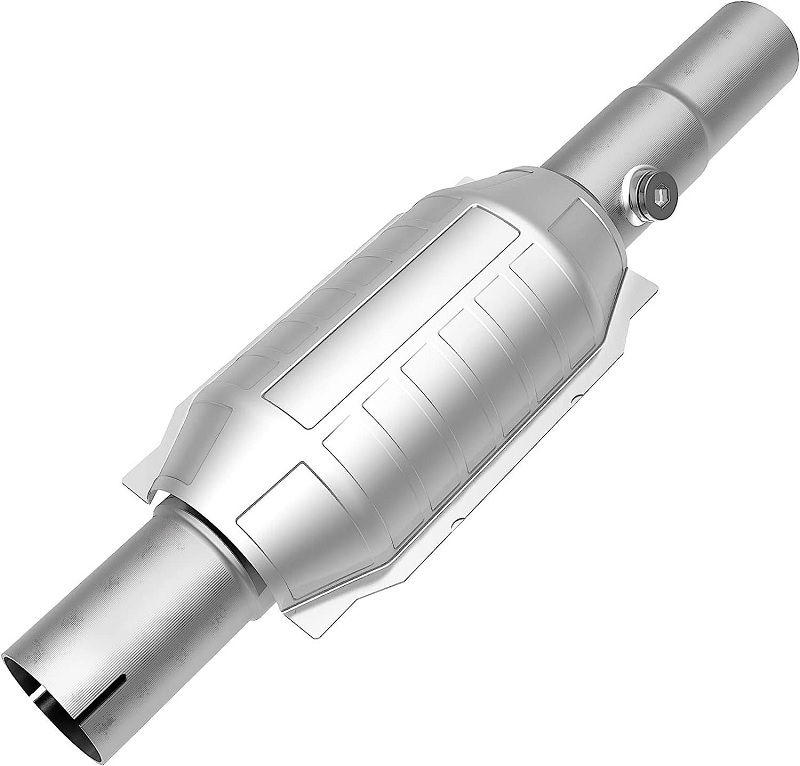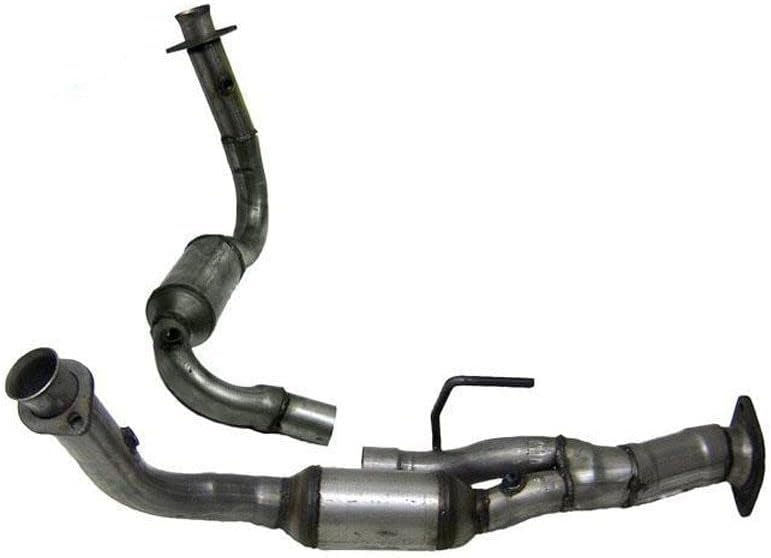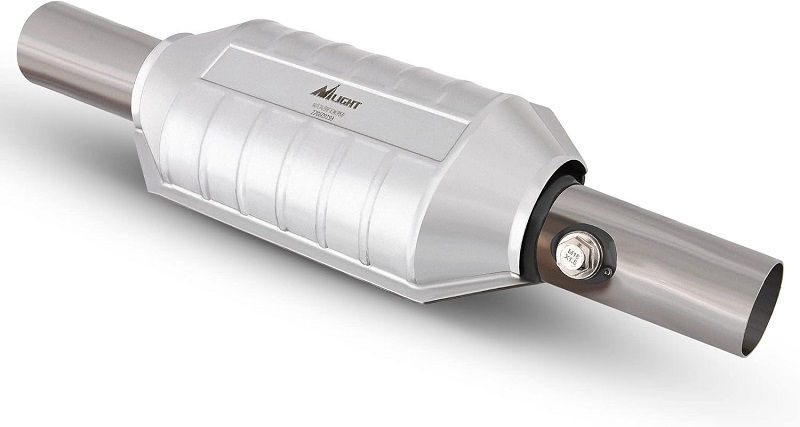This post contains affiliate links. This means I will make a commission at no extra cost to you should you click through and make a purchase [ “As an Amazon Associate, I earn from qualifying purchases.” ]. Read the full disclosure here.
Jeep Grand Cherokee Catalytic Converter GuideMechanic.Com Are you a proud owner of a Jeep Grand Cherokee? If so, you might be familiar with the importance of maintaining its various components to ensure optimal performance.
One crucial component that deserves your attention is the catalytic converter. In this comprehensive blog post, we will delve into the world of Jeep Grand Cherokee catalytic converters, exploring their purpose, functioning, common issues, and much more.
Before we dive into the details, let’s briefly understand what a catalytic converter is. Put simply, it is an emissions control device that is installed in the exhaust system of your Jeep Grand Cherokee.
Its primary function is to convert harmful pollutants, such as carbon monoxide, nitrogen oxides, and hydrocarbons, into less harmful substances like carbon dioxide, nitrogen, and water vapor. By doing so, it helps reduce air pollution and meet the stringent emission standards set by regulatory bodies.
What Does a Catalytic Converter Do?

A catalytic converter is a critical component of your Jeep Grand Cherokee’s exhaust system, and its primary function is to reduce harmful emissions. It achieves this by facilitating a series of chemical reactions that convert toxic gases into less harmful substances. Let’s explore the key processes that occur within a catalytic converter:
Oxidation
The first step in the catalytic converter’s operation is the oxidation of carbon monoxide (CO) and hydrocarbons (HC). Inside the converter, there are two catalysts: platinum and palladium.
See Also: Jeep Dashboard Symbols and Meanings
These catalysts facilitate the reaction between CO and HC with oxygen (O2) to produce carbon dioxide (CO2) and water (H2O). This oxidation process helps eliminate harmful gases from the exhaust.
Reduction
The next phase involves the reduction of nitrogen oxides (NOx) into harmless nitrogen (N2) and oxygen (O2). The platinum and rhodium catalysts in the converter play a crucial role in this reaction.
The reduction process occurs when the nitrogen oxides in the exhaust come into contact with the catalysts and react with carbon monoxide and hydrocarbons, which act as reducing agents. This reaction converts the nitrogen oxides into nitrogen and oxygen, thereby reducing harmful emissions.
Controlled Combustion
In addition to oxidation and reduction, a catalytic converter also facilitates controlled combustion reactions. These reactions help convert any remaining unburned hydrocarbons and carbon monoxide into carbon dioxide and water vapor. This final stage ensures that the exhaust gases leaving the catalytic converter are as clean and environmentally friendly as possible.
By performing these chemical reactions, the catalytic converter significantly reduces the levels of harmful pollutants emitted by your Jeep Grand Cherokee, making it an integral part of the vehicle’s emissions control system.
How Does a Catalytic Converter Work?
Check out this Replacement Part For 05-10 Grand Cherokee 06-10 Commander 3.7L Y Pipe With Catalytic Converter Made In USA

Understanding the inner workings of a catalytic converter can help you appreciate its importance in your Jeep Grand Cherokee. Let’s take a closer look at how a catalytic converter operates:
Structure of a Catalytic Converter
A catalytic converter consists of a metal shell, a ceramic or metal honeycomb structure known as a substrate, and a catalyst coating. The substrate is typically made of ceramic and has a large surface area, providing ample space for the catalyst to facilitate chemical reactions.
Functioning of the Catalyst
The catalyst coating on the substrate contains precious metals such as platinum, palladium, and rhodium. These metals act as catalysts, speeding up the chemical reactions that occur during the conversion process. As the exhaust gases flow through the substrate, they come into contact with the catalyst, allowing the reactions to take place.
The Oxygen Sensor’s Role
To ensure efficient functioning of the catalytic converter, modern vehicles, including the Jeep Grand Cherokee, are equipped with oxygen sensors. These sensors monitor the oxygen levels in the exhaust gases before and after they pass through the converter.
See Also: Jeep Compass Warning Lights
By analyzing the difference in oxygen levels, the vehicle’s engine control unit (ECU) can determine if the converter is functioning optimally. If there is a significant difference in oxygen levels, it may indicate a problem with the catalytic converter.
Types of Catalytic Converters for Jeep Grand Cherokee

When it comes to catalytic converters for your Jeep Grand Cherokee, there are different types available, each catering to specific engine types and emission control requirements. Let’s explore some of the common types:
Two-Way Catalytic Converter
The two-way catalytic converter is commonly used in older Jeep Grand Cherokee models. It primarily focuses on reducing carbon monoxide (CO) and hydrocarbon (HC) emissions. This type of converter does not effectively reduce nitrogen oxide (NOx) emissions, as it lacks the necessary catalysts for the reduction process.
Three-Way Catalytic Converter
Modern Jeep Grand Cherokee models are typically equipped with three-way catalytic converters. As the name suggests, these converters are designed to tackle three main types of emissions: carbon monoxide (CO), hydrocarbons (HC), and nitrogen oxides (NOx).
The three-way converter utilizes a combination of platinum, palladium, and rhodium catalysts to facilitate the oxidation and reduction reactions necessary to convert these harmful gases into less harmful substances.
Diesel Oxidation Catalyst (DOC)
For Jeep Grand Cherokee models equipped with diesel engines, a diesel oxidation catalyst (DOC) is used. Unlike gasoline engines, diesel engines produce different types of pollutants, such as particulate matter and nitrogen oxides.
The DOC helps oxidize carbon monoxide (CO) and hydrocarbons (HC) present in the exhaust gases, reducing their harmful effects on the environment.
It’s essential to select the appropriate type of catalytic converter for your Jeep Grand Cherokee, depending on its model, engine type, and emission control requirements. Consult your vehicle’s manual or a trusted mechanic for guidance.
Signs of a Failing Catalytic Converter
A failing catalytic converter can lead to various issues, affecting your Jeep Grand Cherokee’s performance, fuel efficiency, and emission levels. Here are some common signs that may indicate a problem with your catalytic converter:
Decreased Engine Performance
If you notice a significant decrease in your Jeep Grand Cherokee’s engine performance, such as sluggish acceleration, reduced power, or difficulty maintaining speed, it could be a sign of a failing catalytic converter. A clogged or damaged converter can restrict the flow of exhaust gases, negatively impacting engine performance.
Strange Odors
A malfunctioning catalytic converter can emit unpleasant smells, such as a rotten egg or sulfur-like odor. This odor is often a result of the converter’s inability to efficiently convert hydrogen sulfide (H2S) into odorless sulfur dioxide (SO2). If you detect such odors while driving your Jeep Grand Cherokee, it’s advisable to have your catalytic converter inspected.
Illuminated Check Engine Light
When your Jeep Grand Cherokee’s onboard diagnostics system detects a problem with the catalytic converter, it may trigger the check engine light on your dashboard.
This could indicate issues such as a failing oxygen sensor, a clogged converter, or a malfunctioning catalyst. It’s crucial to have your vehicle diagnosed by a qualified mechanic to determine the exact cause.
Increased Fuel Consumption
If you notice a sudden increase in fuel consumption without any apparent reason, it could be due to a faulty catalytic converter. A malfunctioning converter can disrupt the air-fuel mixture in the engine, leading to inefficient combustion and higher fuel consumption.
Monitoring your Jeep Grand Cherokee’s fuel economy and addressing any drastic changes promptly can help identify potential catalytic converter issues.
Rattling Noises
A loose or damaged catalytic converter can produce rattling noises, especially when the vehicle is idling or accelerating. These noises may indicate that the internal components of the converter have deteriorated or come loose, affecting its performance and potentially causing further damage to the exhaust system.
Emission Test Failures
If your Jeep Grand Cherokee fails an emission test, it could be due to a malfunctioning catalytic converter. The converter plays a vital role in reducing emissions, and any issues with its functioning can result in higher pollutant levels. Failing an emission test is a clear indication that the catalytic converter requires attention.
See Also: Jeep Grand Cherokee Alternator
If you encounter any of these signs, it’s crucial to have your Jeep Grand Cherokee inspected by a qualified mechanic. They can accurately diagnose the problem and recommend the necessary repairs or replacement.
Causes of Catalytic Converter Failure
Several factors can contribute to the failure or malfunctioning of a catalytic converter in your Jeep Grand Cherokee. Understanding these causes can help you take preventive measures and prolong the converter’s lifespan. Let’s explore some common causes:
Engine Misfires
Engine misfires can lead to unburned fuel entering the exhaust system, which can overheat and damage the catalytic converter.
Misfires can be caused by various factors, such as faulty spark plugs, ignition coils, fuel injectors, or oxygen sensors. Regular maintenance and prompt identification and resolution of engine misfires can help prevent catalytic converter damage.
Contaminated Fuel
Using contaminated or low-quality fuel can introduce harmful substances into the catalytic converter, graduallydamaging its internal components.
Contaminants like sulfur, lead, and other impurities can build up on the catalyst surface, reducing its effectiveness over time. It’s essential to ensure that you use high-quality fuel from reputable sources to minimize the risk of fuel-related catalytic converter damage.
Overheating
Excessive heat can cause the catalyst inside the converter to deteriorate or melt, rendering it ineffective. Overheating can occur due to various reasons, including engine overheating, exhaust system leaks, or a malfunctioning cooling system.
Regular maintenance checks, proper cooling system maintenance, and prompt repairs of any leaks can help prevent catalytic converter damage due to overheating.
Physical Damage
The catalytic converter is located underneath your Jeep Grand Cherokee and is susceptible to physical damage from road debris, speed bumps, or other objects. A major impact can dent or rupture the converter, affecting its performance and possibly causing exhaust leaks.
It’s crucial to be mindful of your driving environment and avoid rough terrains to minimize the risk of physical damage to the catalytic converter.
Excessive Oil Consumption
If your Jeep Grand Cherokee experiences excessive oil consumption, it can lead to oil fouling in the catalytic converter. Oil fouling occurs when oil enters the exhaust system through worn piston rings, valve seals, or other engine components.
The oil coats the catalyst, preventing it from effectively converting harmful emissions. Regular oil changes and addressing any excessive oil consumption issues promptly can help prevent catalytic converter damage.
Fuel Additives and Contaminants
While fuel additives can enhance the performance of your vehicle’s engine, certain additives can be corrosive to the catalytic converter. It’s crucial to use fuel additives that are specifically labeled as safe for use with catalytic converters.
Additionally, using contaminated or adulterated additives can introduce harmful substances that can damage the converter. Always follow the manufacturer’s recommendations and use reputable fuel additives to avoid catalytic converter damage.
Age and Wear
Over time, the internal components of a catalytic converter can degrade due to normal wear and tear. The catalyst coating can become less efficient, reducing its ability to convert harmful emissions effectively.
While age-related wear is inevitable, regular maintenance and prompt replacement of a worn-out catalytic converter can help maintain optimal performance and prevent further damage to the exhaust system.
By addressing these potential causes and taking preventive measures, you can prolong the lifespan of your Jeep Grand Cherokee’s catalytic converter and ensure its optimal functioning.
How to Replace a Catalytic Converter
If you encounter a faulty catalytic converter in your Jeep Grand Cherokee, you may need to consider replacing it. While replacing a catalytic converter is more complex than routine maintenance tasks, it can be done with the right tools and knowledge. Here’s a general overview of the replacement process:
1. Preparation
Begin by ensuring that you have the necessary tools and replacement catalytic converter compatible with your Jeep Grand Cherokee’s make, model, and engine type. It’s also essential to park your vehicle on a level surface and engage the parking brake for safety.
2. Raise the Vehicle
Using a hydraulic jack, carefully raise the front end of your Jeep Grand Cherokee. Secure it with jack stands to ensure stability and prevent any accidental movement while you work underneath the vehicle. Always follow proper safety precautions when working with a lifted vehicle.
3. Locate the Catalytic Converter
The catalytic converter is typically located in the exhaust system, between the exhaust manifold and the muffler. Identify its position underneath your Jeep Grand Cherokee and inspect the connections to determine the best approach for replacement.
4. Disconnect the Exhaust System
Before removing the catalytic converter, you’ll need to disconnect it from the exhaust system. Depending on your vehicle’s configuration, this may involve removing bolts or clamps that secure the converter to the exhaust pipes. Carefully disconnect any sensors, brackets, or hangers attached to the converter as well.
5. Remove the Old Catalytic Converter
Once the exhaust system is disconnected, you can proceed with removing the old catalytic converter. Loosen any remaining bolts or clamps and carefully slide the converter out of the exhaust system. Be cautious of the weight and ensure proper support while removing it from the vehicle.
6. Install the New Catalytic Converter
Take your new catalytic converter and position it correctly in the exhaust system. Ensure that it aligns with the exhaust pipes and connections properly. Use new gaskets, if necessary, to ensure a proper seal. Reattach any sensors, brackets, or hangers that were removed during the disconnection process.
7. Reconnect the Exhaust System
Once the new catalytic converter is securely in place, reconnect the exhaust system. Use the appropriate bolts or clamps to secure the converter to the exhaust pipes, ensuring a tight fit. Double-check all connections and ensure that the exhaust system is properly aligned and supported.
8. Lower the Vehicle
Carefully lower your Jeep Grand Cherokee from the jack stands using a hydraulic jack. Ensure that the vehicle is on a level surface and remove the jack stands. Lower the vehicle slowly and cautiously, ensuring that it rests securely on all four wheels.
9. Test the Replacement
Start your Jeep Grand Cherokee’s engine and let it run for a few minutes to ensure that the new catalytic converter is functioning correctly. Listen for any unusual sounds or leaks and monitor the vehicle’s performance. If everything appears to be in order, you can consider the replacement process successful.
See Also: 2007 Jeep Commander Problems
It’s important to note that replacing a catalytic converter can be a complex task, and it requires mechanical expertise. If you’re not confident in your abilities or lack the necessary tools, it’s highly recommended to consult a qualified mechanic for professional assistance.
Catalytic Converter Maintenance Tips
Proper maintenance of your Jeep Grand Cherokee’s catalytic converter is crucial to ensure its longevity and efficient functioning. Here are some essential maintenance tips to keep in mind:
Regular Inspections
Periodically inspect your catalytic converter for any signs of damage, such as physical dents, cracks, or leaks. Look out for loose or corroded connections and ensure that the converter is securely mounted. Early detection of issues can help prevent further damage and costly repairs.
Fuel Quality
Using high-quality fuel and avoiding contaminated or adulterated fuel is essential for the optimal functioning of your catalytic converter. Ensure that you purchase fuel from reputable sources and avoid using additives that are not specifically labeled as safe for catalytic converters.
Engine Maintenance
Maintaining your Jeep Grand Cherokee’s engine in good condition is vital for the health of the catalytic converter. Follow the recommended maintenance schedule for oil changes, air filter replacements, spark plug inspections, and other engine-related tasks. Promptly address any engine issues, such as misfires or excessive oil consumption, to prevent damage to the converter.
Exhaust System Checks
Regularly inspect the entire exhaust system, including the pipes, muffler, and connectors, for any signs of damage or leaks. A damaged or leaking exhaust system can negatively impact the performance and efficiency of the catalytic converter. Address any issues promptly to prevent further damage.
Safe Driving Habits
Practicing safe driving habits can indirectly contribute to the longevity of your catalytic converter. Avoid aggressive driving, excessive idling, and overloading your vehicle, as these can put additional strain on the exhaust system and the converter. Drive responsibly and follow recommended speed limits and traffic regulations.
See Also: Jeep Liberty Catalytic Converter
By following these maintenance tips and staying proactive, you can ensure that your Jeep Grand Cherokee’s catalytic converter remains in optimal condition, contributing to a cleaner and more efficient driving experience.
- Custom Lifted Diesel Trucks for Sale - December 20, 2025
- New Lifted Diesel Trucks for Sale - December 19, 2025
- Old Lifted Diesel Trucks for Sale - December 18, 2025
